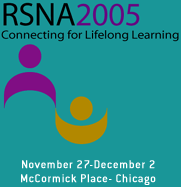
Abstract Archives of the RSNA, 2005
SSQ01-05
Comparison of the Performance of Two Commercially Available CAD Systems in the Detection of Invasive Breast Cancers Presenting as Non-Calcified Masses Measuring Less than 16 mm or Invasive Lobular Carcinoma Regardless of Size
Scientific Papers
Presented on December 1, 2005
Presented as part of SSQ01: Breast (Computer-assisted Detection)
Richard LeRoy Ellis MD, Presenter: Nothing to Disclose
Andrew A. Meade MD, Abstract Co-Author: Nothing to Disclose
Wende W. Logan-Young MD, Abstract Co-Author: Nothing to Disclose
Victoria A. Nguyen DO, Abstract Co-Author: Nothing to Disclose
Peter Joseph Dempsey MD, Abstract Co-Author: Nothing to Disclose
Kathy Willison, Abstract Co-Author: Nothing to Disclose
Michelle Mathiason, Abstract Co-Author: Nothing to Disclose
et al, Abstract Co-Author: Nothing to Disclose
To compare the performance of two commercially available CAD systems in the detection of invasive breast cancers presenting as non-calcified masses measuring less than 16 mm or invasive lobular carcinoma regardless of size.
Two commercially available CAD systems were used to evaluate mammograms submitted from three institutions providing consecutive invasive carcinomas meeting our selection criteria. A total of 213 cases were evaluated with 200 presenting as unifocal, 8 multifocal, and 5 with bilateral disease. All masses were characterized using the BIRADSTM classification. Case sensitivity was determined by the percentage of cases correctly marked by CAD on at least one image of a two-view mammogram. Mass view sensitivity was determined by the number of cancers correctly marked divided by the total number of all visible cancers. Surgical biopsy results were available for each breast cancer case. In addition, 51 normal control cases were used to determine specificity and false marker rate.
Case sensitivity, image sensitivity, case specificity, and case mass false marker rate for R2 ImageCheckerTM M1000 (Version 5.0A) was 83.1%, 66.4%, 39.2%, and 1.08. Case sensitivity, image sensitivity, case specificity, and case mass false marker rate for iCAD Second Look® (Version 6.0 Mid Operating Point) was 62.4%, 44.1%, 31.4%, and 1.41. R2's performance was statistically significantly better than iCAD for case sensitivity and image sensitivity (McNamars test, p < 0.001 and p < 0.001). Although not statistically significant, R2 had a higher case specificity and a lower false marker rate than iCAD.
The R2 (Version 5.0A) demonstrated statistically significant better case and image sensitivity along with a lower case mass false marker rate than iCAD (Version 6.0 Mid Operating Point) for invasive breast cancers presenting as non-calcified masses measuring less than 16 mm or invasive lobular carcinoma regardless of size. CAD algorithm improvements in the detection of invasive breast cancers less than 16 mm is important in aiding the radiologist interpreting screening mammography, as tumor size at detection is a critical prognostic indicator in breast cancer survival.
Ellis, R,
Meade, A,
Logan-Young, W,
Nguyen, V,
Dempsey, P,
Willison, K,
Mathiason, M,
et al, ,
Comparison of the Performance of Two Commercially Available CAD Systems in the Detection of Invasive Breast Cancers Presenting as Non-Calcified Masses Measuring Less than 16 mm or Invasive Lobular Carcinoma Regardless of Size. Radiological Society of North America 2005 Scientific Assembly and Annual Meeting, November 27 - December 2, 2005 ,Chicago IL.
http://archive.rsna.org/2005/4406144.html

